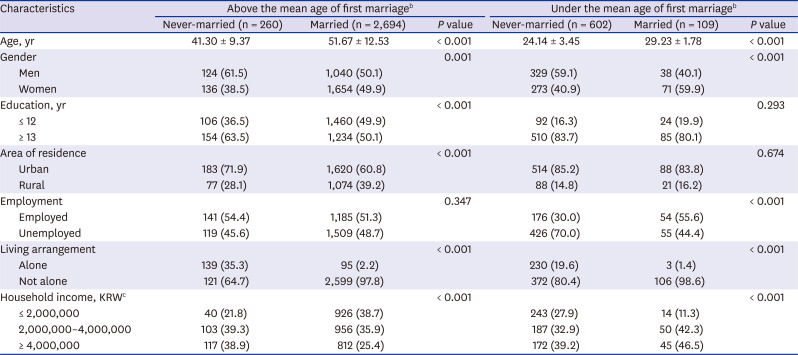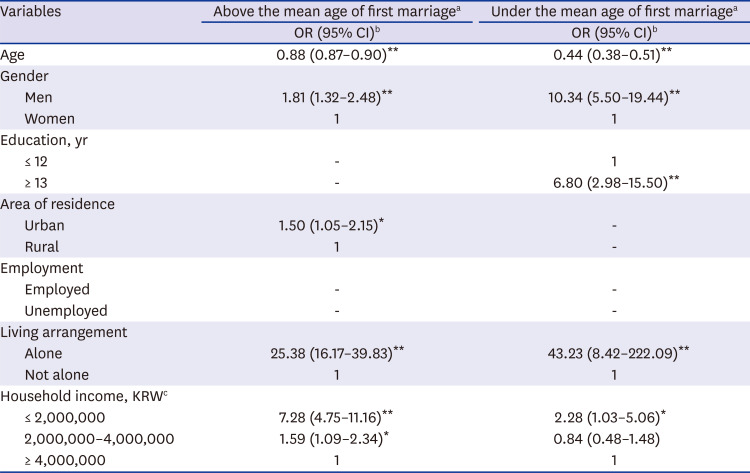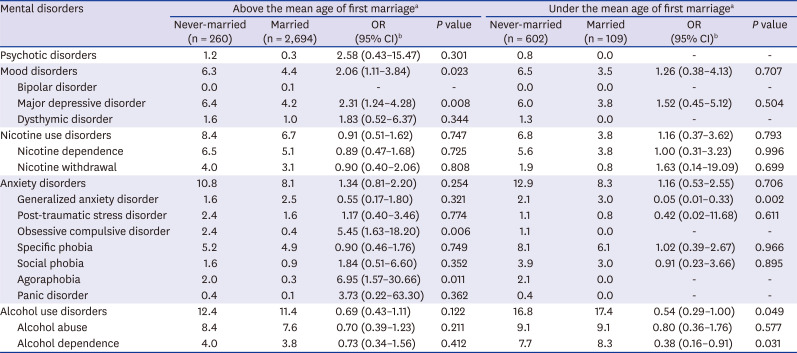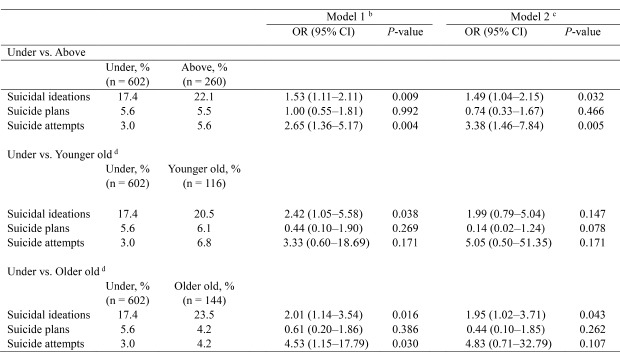2. Kisker EE, Goldman N. Perils of single life and benefits of marriage. Soc Biol. 1987; 34(3-4):135–152. PMID:
3451361.

3. Nilsson PM, Nilsson JÅ, Östergren PO, Berglund G. Social mobility, marital status, and mortality risk in an adult life course perspective: the Malmö preventive project. Scand J Public Health. 2005; 33(6):412–423. PMID:
16332606.

4. Ross CE, Mirowsky J, Goldsteen K. The impact of the family on health: the decade in review. J Marriage Fam. 1990; 52(4):1059–1078.

5. Cutright P, Fernquist R. Marital status integration, psychological well-being, and suicide acceptability as predictors of marital status differentials in suicide rates. Soc Sci Res. 2005; 34(3):570–590.

6. Gove WR. Sex, marital status, and mortality. AJS. 1973; 79(1):45–67. PMID:
4740470.

7. Rogers RG. Marriage, sex, and mortality. J Marriage Fam. 1995; 57(2):515–526.

8. Gove WR. Sex, marital status and suicide. J Health Soc Behav. 1972; 13(2):204–213. PMID:
5042040.

9. Kposowa AJ. Marital status and suicide in the national longitudinal mortality study. J Epidemiol Community Health. 2000; 54(4):254–261. PMID:
10827907.

10. Qin P, Agerbo E, Mortensen PB. Suicide risk in relation to socioeconomic, demographic, psychiatric, and familial factors: a national register-based study of all suicides in Denmark, 1981–1997. Am J Psychiatry. 2003; 160(4):765–772. PMID:
12668367.

11. Qin P, Agerbo E, Westergård-Nielsen N, Eriksson T, Mortensen PB. Gender differences in risk factors for suicide in Denmark. Br J Psychiatry. 2000; 177(6):546–550. PMID:
11104395.

14. Umberson D, Wortman CB, Kessler RC. Widowhood and depression: explaining long-term gender differences in vulnerability. J Health Soc Behav. 1992; 33(1):10–24. PMID:
1619255.

15. Waldron I, Hughes ME, Brooks TL. Marriage protection and marriage selection--prospective evidence for reciprocal effects of marital status and health. Soc Sci Med. 1996; 43(1):113–123. PMID:
8816016.

16. Yoo HJ, Hyun SM. The effects of economic resources on marriage-delaying. Korea J Popul Stud. 2010; 33(1):75–101.
17. Cargan L, Melko K. Singles: Myths and Realities. London: SAGE;1982.
18. Lewis KG. Single Heterosexual Women through the Life Cycle. New York, NY: Guilford;1994.
19. DePaulo BM, Morris WL. The unrecognized stereotyping and discrimination against singles. Curr Dir Psychol Sci. 2006; 15(5):251–254.

20. Cain M. The Childless Revolution. New York, NY: Diversion Books;2013.
21. Himawan KK, Bambling M, Edirippulige S. What does it mean to be single in Indonesia? Religiosity, social stigma, and marital status among never-married Indonesian adults. Sage Open. 2018; 8(3):1–9.

22. Afifi TO, Cox BJ, Enns MW. Mental health profiles among married, never-married, and separated/divorced mothers in a nationally representative sample. Soc Psychiatry Psychiatr Epidemiol. 2006; 41(2):122–129. PMID:
16467954.

23. Holt-Lunstad J, Birmingham W, Jones BQ. Is there something unique about marriage? The relative impact of marital status, relationship quality, and network social support on ambulatory blood pressure and mental health. Ann Behav Med. 2008; 35(2):239–244. PMID:
18347896.

24. Inaba A, Thoits PA, Ueno K, Gove WR, Evenson RJ, Sloan M. Depression in the United States and Japan: gender, marital status, and SES patterns. Soc Sci Med. 2005; 61(11):2280–2292. PMID:
16115712.

25. Palner J, Mittelmark MB. Differences between married and unmarried men and women in the relationship between perceived physical health and perceived mental health. Nor Epidemiol. 2002; 12(1):55–61.

26. Grant BF, Goldstein RB, Chou SP, Huang B, Stinson FS, Dawson DA, et al. Sociodemographic and psychopathologic predictors of first incidence of DSM-IV substance use, mood and anxiety disorders: results from the wave 2 national epidemiologic survey on alcohol and related conditions. Mol Psychiatry. 2009; 14(11):1051–1066. PMID:
18427559.

27. Chang S, Abdin E, Shafie S, Sambasivam R, Vaingankar JA, Ma S, et al. Prevalence and correlates of generalized anxiety disorder in Singapore: results from the second Singapore mental health study. J Anxiety Disord. 2019; 66:102106. PMID:
31252250.

28. Ansseau M, Fischler B, Dierick M, Albert A, Leyman S, Mignon A. Socioeconomic correlates of generalized anxiety disorder and major depression in primary care: the GADIS II study (generalized anxiety and depression impact survey II). Depress Anxiety. 2008; 25(6):506–513. PMID:
17595015.

29. Liu HL, Wang HC, Yang MJ. Factors associated with an unusual increase in the elderly suicide rate in Taiwan. Int J Geriatr Psychiatry. 2006; 21(12):1219–1221. PMID:
17124695.

30. Johnson NJ, Backlund E, Sorlie PD, Loveless CA. Marital status and mortality: the national longitudinal mortality study. Ann Epidemiol. 2000; 10(4):224–238. PMID:
10854957.
31. Kim JW, Jung HY, Won DY, Noh JH, Shin YS, Kang TI. Suicide trends according to age, gender, and marital status in South Korea. Omega (Westport). 2019; 79(1):90–105. PMID:
28622733.

32. Park SK, Lee CK, Kim H. Suicide mortality and marital status for specific ages, genders, and education levels in South Korea: using a virtually individualized dataset from national aggregate data. J Affect Disord. 2018; 237:87–93. PMID:
29803100.

33. Cho MJ, Hahm BJ, Suh DW, Hong JP, Bae JN, Kim JK, et al. Development of a Korean version of the composite international diagnostic interview (K-CIDI). J Korean Neuropsychiatr Assoc. 2002; 41(1):123–137.
34. World Health Organization. CIDI, Core Version 2.1 Interviewer's Manual. Geneva: World Health Organization;1997.
35. American Psychiatric Association. Diagnostic and Statistical Manual of Mental Disorders. 4th ed. Washington, D.C.: American Psychiatric Press;1994.
36. Bertolote JM, Fleischmann A, De Leo D, Bolhari J, Botega N, De Silva D, et al. Suicide attempts, plans, and ideation in culturally diverse sites: the WHO SUPRE-MISS community survey. Psychol Med. 2005; 35(10):1457–1465. PMID:
16164769.

37. Williams K. The transition to widowhood and the social regulation of health: consequences for health and health risk behavior. J Gerontol B Psychol Sci Soc Sci. 2004; 59(6):S343–9. PMID:
15576865.

38. House JS, Landis KR, Umberson D. Social relationships and health. Science. 1988; 241(4865):540–545. PMID:
3399889.

39. Waite LJ. Does marriage matter? Demography. 1995; 32(4):483–507. PMID:
8925942.

40. Eng PM, Kawachi I, Fitzmaurice G, Rimm EB. Effects of marital transitions on changes in dietary and other health behaviours in US male health professionals. J Epidemiol Community Health. 2005; 59(1):56–62. PMID:
15598728.

41. Lee S, Cho E, Grodstein F, Kawachi I, Hu FB, Colditz GA. Effects of marital transitions on changes in dietary and other health behaviours in US women. Int J Epidemiol. 2005; 34(1):69–78. PMID:
15231759.

42. Labrador FJ, Estupiñá FJ, Bernaldo-de-Quirós M, Fernández-Arias I, Alonso P, Ballesteros F, et al. Treatment of anxiety disorders in a psychology clinic. Span J Psychol. 2015; 18:E83. PMID:
26514227.

43. Meng X, D'Arcy C. Common and unique risk factors and comorbidity for 12-month mood and anxiety disorders among Canadians. Can J Psychiatry. 2012; 57(8):479–487. PMID:
22854030.

44. Lindeman S, Hämäläinen J, Isometsä E, Kaprio J, Poikolainen K, Heikkinen M, et al. The 12-month prevalence and risk factors for major depressive episode in Finland: representative sample of 5993 adults. Acta Psychiatr Scand. 2000; 102(3):178–184. PMID:
11008852.

45. Williams DR, Herman A, Stein DJ, Heeringa SG, Jackson PB, Moomal H, et al. Twelve-month mental disorders in South Africa: prevalence, service use and demographic correlates in the population-based South African stress and health study. Psychol Med. 2008; 38(2):211–220. PMID:
17903333.

46. Subramaniam M, Abdin E, Vaingankar JA, Chong SA. Obsessive--compulsive disorder: prevalence, correlates, help-seeking and quality of life in a multiracial Asian population. Soc Psychiatry Psychiatr Epidemiol. 2012; 47(12):2035–2043. PMID:
22526825.

47. Kendler KS, Lönn SL, Salvatore J, Sundquist J, Sundquist K. Effect of marriage on risk for onset of alcohol use disorder: a longitudinal and co-relative analysis in a Swedish national sample. Am J Psychiatry. 2016; 173(9):911–918. PMID:
27180900.

48. Grant BF, Goldstein RB, Saha TD, Chou SP, Jung J, Zhang H, et al. Epidemiology of DSM-5 alcohol use disorder: results from the national epidemiologic survey on alcohol and related conditions III. JAMA Psychiatry. 2015; 72(8):757–766. PMID:
26039070.
49. Amin-Esmaeili M, Rahimi-Movaghar A, Sharifi V, Hajebi A, Mojtabai R, Radgoodarzi R, et al. Alcohol use disorders in Iran: prevalence, symptoms, correlates, and comorbidity. Drug Alcohol Depend. 2017; 176:48–54. PMID:
28514696.

50. Lee HK, Chou SP, Cho MJ, Park JI, Dawson DA, Grant BF. The prevalence and correlates of alcohol use disorders in the United States and Korea--a cross-national comparative study. Alcohol. 2010; 44(4):297–306. PMID:
20570084.

51. Um DW, Hong KZ. The impact of housing-cost burden on transition to marriage. Social Welfare Policy. 2019; 46(3):33–61.
52. Yoo GS. Effects of consumption wants and expected wedding expenses on expected marriage age among undergraduate students. Health Soc Welf Rev. 2014; 34(2):367–392.
53. Yi S, Lee S. A cause analysis of low fertility and population aging in Korea: evidence from economic factors in marriage determination. Econ Anal. 2011; 17(3):131–166.
54. Jun CA, Park SY. The effect of parenting stress and social support on marial satisfaction. J Korean Home Econ Assoc. 1996; 34(5):115–130.
55. Keum JH, Kim DS. The casual relationship among the father's participation in childcare, job satisfaction, parenting stress, and marital satisfaction of working mother. Fam Environ Res. 2014; 52(2):141–150.

56. Seo YE. Factors influencing to suicidal ideation by age group in Korean adults [master's thesis]. Seoul: Yonsei University;2013.
57. Shin SJ, Cho YT. Social capital and suicidal impulse. J Korean Soc Health Educ Promot. 2007; 24(3):35–49.
58. Kim SY, Jung MY, Kim KN. Factors associated with suicidal ideation by age group among Korean adults: using the fifth Korea National Health and Nutrition Examination Survey (KNHANES V, 2012). J Korean Soc Health Educ Promot. 2014; 31(2):1–14.
59. Jung ES, Shim MS. Factors influencing suicidal ideation by age group in adults. J Korean Public Health Nurs. 2016; 30(2):326–336.

60. Eum C. A Phenomenological Study of Never Married Women over 40. Santa Barbara: Pacifica Graduate Institute;2005.
61. Gruetzmacher A. The lived experience of being single for the never-married woman over age thirty [master's thesis]. Tucson: The University of Arizona;2001.
62. Beesdo K, Pine DS, Lieb R, Wittchen HU. Incidence and risk patterns of anxiety and depressive disorders and categorization of generalized anxiety disorder. Arch Gen Psychiatry. 2010; 67(1):47–57. PMID:
20048222.

63. Lim L, Ng TP, Chua HC, Chiam PC, Won V, Lee T, et al. Generalised anxiety disorder in Singapore: prevalence, co-morbidity and risk factors in a multi-ethnic population. Soc Psychiatry Psychiatr Epidemiol. 2005; 40(12):972–979. PMID:
16249971.

64. Muhsen K, Lipsitz J, Garty-Sandalon N, Gross R, Green MS. Correlates of generalized anxiety disorder: independent of co-morbidity with depression: findings from the first Israeli national health interview survey (2003–2004). Soc Psychiatry Psychiatr Epidemiol. 2008; 43(11):898–904. PMID:
18642124.
65. Lewis KG, Moon S. Always single and single again women: a qualitative study. J Marital Fam Ther. 1997; 23(2):115–134. PMID:
9134477.










 PDF
PDF Citation
Citation Print
Print




 XML Download
XML Download